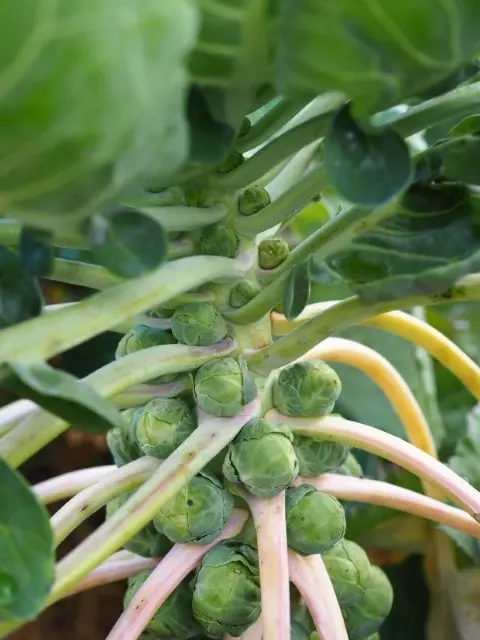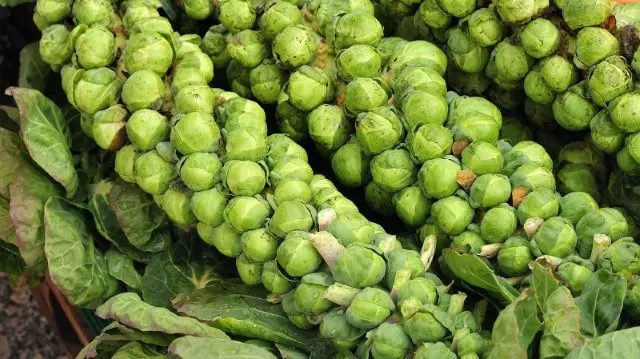Harvesting brussels sprouts will provide very nutritious vegetables for your home. A single brussels sprout plant will provide you with an abundance of vegetables. In the next paragraphs, I will explain a question that arises for all of us as gardeners, especially the first time we grow Brussels sprouts. When are Brussel sprouts ready to harvest and how to know when Brussel sprouts are ready to harvest? I encourage you to read and pay attention until the end of the article to learn how and when to harvest Brussel sprouts and make the most of your harvest. Let’s get started!
Table of Contents
Varieties of Brussels Sprouts
There are different varieties of brussels sprouts, and this can make the time to harvest Brussel sprouts vary somewhat. These are some best-known varieties of brussels sprouts:
Open Pollination
Brussel Sprouts Long Island Improved: This variety can be harvested 90 days after planting. A little more difficult to produce firm and uniform heads.
Rubine: One of the varieties of brussels sprouts that takes longer to be ready to harvest (105 days). Red plants and sprouts.
Hybrid Varieties
Brussel Sprouts Catskill: Variety that grows 2 to 4 feet (60 to 120 cm) tall and produces many heads. Harvested in approximately 100 days.
Oliver: Easy to harvest, ready to harvest in 85 days.
Prince Marvel: This brussels sprout is sweet, ready to harvest in 90 days.
Bubbles: A variety of brussels sprouts more tolerant to heat. In 82 days, you will be able to harvest this variety.
- Brassica oleracea - non-gmo, open-pollinated, heirloom, untreated
- The most well known compact Brussels sprout with very heavy yields!
- A workhorse variety that produces very flavorful sprouts. Each compact, 24″ tall plant yields around 75-100 dark green, 1-2″ sprouts over a long period!
When to Harvest Brussel Sprouts
When to Harvest Brussel Sprouts? You should harvest Brussel sprouts when they are 1″ (2.5 cm) in diameter. Brussels sprouts are a cool climate crop, tolerating some frost and snowfall. In warmer climates, they can survive all winter without any protection.
Therefore, the best time to harvest Brussel sprouts is after the first frost of autumn. The cold frost will make brussels sprouts sweeter and tastier.
You will be able to continue harvesting Brussel sprouts through the winter because the plant is very cold and hardy. It is important to harvest Brussel sprouts at the right time to get the best flavor.
Keep in mind that cold slows the growth of the plant, and it will produce less. That is why you should harvest Brussel sprouts before winter arrives.
Brussels sprouts take a long time to ripen, sometimes more than 105 days, although other varieties such as bubble brussels sprouts take only 80 days to ripen.
The most important thing is to pick the brussels sprouts before they start to turn yellow and open. The size of the Brussels sprouts should be about 1″ (2.5 cm) in diameter.
Not all sprouts will be ready to harvest at the same time, so you should get brussels sprouts from different parts of the plant.

When are Brussels Sprouts Ready to Pick
When are Brussels Sprouts Ready to Pick? Brussels sprouts are ready for picking when they are approximately 1″ (2.5 cm) in diameter and firm to the touch.
It is important not to let the brussels sprouts turn yellow on the plant and begin to open. In that case, they will be hard and bitter to consume.
If it is possible to wait for one or two frosts, it will be better to harvest brussels sprouts with a better flavor.
How to Harvest Brussel Sprouts
How to Harvest Brussel Sprouts? You should be able to harvest Brussel sprouts by hand or using a sharp knife. You will notice that the brussels sprouts will be ripe from the bottom first, the plant ripens from the bottom upwards.
Start harvesting Brussel sprouts from the bottom of the plant and pull them by hand or use a sharp knife. It is important not to damage the plant so that it continues to produce.
Pick the buds before they turn yellow and start to open, otherwise, they will be bitter and hard. If the plant has already had some frost, you will notice that the taste of brussels sprouts is sweeter and tastier.
As you harvest the Brussel sprouts, remove the leaves from the lower part of the plant, this will encourage the plant to continue producing.
You should harvest the entire plant when you notice that all the brussels sprouts are maturing at the same time or the weather is too cold for it to continue to produce. The leaves and stems of brussels sprouts are edible. You should consume the leaves in soups, and the stems can be cooked as you would cook broccoli or prepare a vegetable broth.
I hope this article has been useful for you to learn when are Brussel sprouts ready to harvest and how to know when Brussel sprouts are ready to harvest and get the maximum yield from your crop.
We recommend our article about How and When to Harvest Broccoli. Broccoli and Brussels sprouts belong to the same family.



